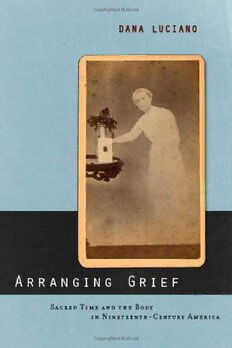
Arranging Grief: Sacred Time and the Body in Nineteenth-Century America PDF
358 Pages·2007·0.971 MB·English
Most books are stored in the elastic cloud where traffic is expensive. For this reason, we have a limit on daily download.
Preview Arranging Grief: Sacred Time and the Body in Nineteenth-Century America
Description:
2008 Winner, MLA First Book PrizeCharting the proliferation of forms of mourning and memorial across a century increasingly concerned with their historical and temporal significance, Arranging Grief offers an innovative new view of the aesthetic, social, and political implications of emotion. Dana Luciano argues that the cultural plotting of grief provides a distinctive insight into the nineteenth-century American temporal imaginary, since grief both underwrote the social arrangements that supported the nation’s standard chronologies and sponsored other ways of advancing history.Nineteenth-century appeals to grief, as Luciano demonstrates, diffused modes of "sacred time" across both religious and ostensibly secular frameworks, at once authorizing and unsettling established schemes of connection to the past and the future. Examining mourning manuals, sermons, memorial tracts, poetry, and fiction by Harriet Beecher Stowe, William Apess, James Fenimore Cooper, Catharine Maria Sedgwick, Susan Warner, Harriet E. Wilson, Herman Melville, Frances E. W. Harper, Frederick Douglass, Abraham Lincoln, Elizabeth Keckley, and Ralph Waldo Emerson, Luciano illustrates the ways that grief coupled the affective body to time. Drawing on formalist, Foucauldian, and psychoanalytic criticism, Arranging Grief shows how literary engagements with grief put forth ways of challenging deep-seated cultural assumptions about history, progress, bodies, and behaviors.
See more
The list of books you might like
Most books are stored in the elastic cloud where traffic is expensive. For this reason, we have a limit on daily download.
